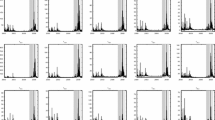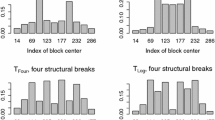Abstract
It is common practice to identify the number and sources of shocks that move, e.g., ATM implied volatilities by principal components analysis. This approach, however, is likely to result in a loss of information, since the surface structure of implied volatilities is neglected. In this paper we analyze the implied volatility surface along maturity slices with a common principal components analysis (CPC), known from morphometrics. In CPC analysis, the space spanned by the eigenvectors is identical across groups, whereas variances associated with the common principal components vary. Our analysis shows that implied volatility surface dynamics can be traced back to a common eigenstructure in maturity slices. This empirical result is used to set up a factor model for implied volatility surface dynamics.
Similar content being viewed by others
References
AÏt-Sahalia, Y. and A. Lo. (2000). “Nonparametric Risk Management and Implied Risk-Aversion,” Journal of Econometrics 94, 9¶51.
Akaike, H. (1973). “Information Theory and an Extension of the Maximum Likelihood Principle.” In the 2nd International Symposium on Information Theory. Budapest: Akademiai Kiado.
Alexander, C. (2001). “Principles of the Skew,” Risk 14(1), S29¶S32.
Avellaneda, M. and Y. Zhu. (1997). “An E-ARCH Model for the Term-Structure of Implied Volatility of FX Options,” Applied Mathematical Finance 4, 81¶100.
Basilevsky, A. (1994). Statistical Factor Analysis and Related Methods: Theory and Applications. Wiley Series in Probability and Mathematical Statistics. New York: Wiley.
Bates, D. (1996). “Jumps and Stochastic Volatility: Exchange Rate Processes Implicit in Deutsche Mark Options,” Review of Financial Studies 9, 69¶107.
Bera, A.K. and C.M. Jarque. (1982). “Model Specification Tests: A Simultaneous Approach,” Journal of Econometrics 20, 59¶82.
Black, F. (1976). “Studies of Stock Price Volatility Changes.” In Proceedings of the 1976 Meetings of the American Statistical Association, pp. 177¶181.
Black, F. and M. Scholes. (1973). “The Pricing of Options and Corporate Liabilities,” Journal of Political Economy 81, 637¶654.
Box, G.E.P. and D.A. Pierce. (1970). “Distribution of Residual Correlations in Autoregressive-Integrated Moving Average Time Series Models,” Journal of the American Statistical Association 65, 1509¶1526.
Cont, R. and J. da Fonseca. (2002). “The Dynamics of Implied Volatility Surfaces,” Quantitative Finance 2(1), 45¶602.
Derman, E. (1999). “Regimes of Volatility.” In Quantitative Strategies Research Notes. Goldman Sachs.
Dumas, B., J. Fleming, and R.E. Whaley. (1998). Implied Volatility Functions: Empirical Tests,” Journal of Finance 80(6), 2059¶2106.
Derman, E. and M. Kamal. (1997). “The Patterns of Change in Implied Index Volatilities.” In Quantitative Strategies Research Notes. Goldman Sachs.
Eberlein, E. and K. Prause. (2002). “The Generalized Hyperbolic Model: Financial Derivatives and Risk Measures.” In H. Geman, D. Madan, S. Pliska, and T. Vorst (eds.), Mathematical Finance—Bachelier Congress 2000. New York: Springer, pp. 245¶267.
Fengler, M.R., W. Härdle, and E. Mammen. (2003). “Implied Volatility String Dynamics,” SfB 373 Discussion Paper, Humboldt-Universität zu Berlin.
Fengler, M.R., W. Härdle, and P. Schmidt. (2002). “Common Factors Governing VDAX Movements and the Maximum Loss,” Journal of Financial Markets and Portfolio Management 16(1), 16¶29.
Fengler, M.R. and Q. Wang. (2003). “Fitting the Smile Revisited: A Least Squares Kernel Estimator for the Implied Volatility Surface,” SfB 373 Discussion Paper 2003-25, Humboldt-Universität zu Berlin.
Flury, B. (1988). Common Principal Components and Related Multivariate Models. Wiley Series in Probability and Mathematical Statistics. New York: Wiley.
Flury, B. and W. Gautschi.(1986). “An Algorithm for Simultaneous Orthogonal Transformations of Several Positive Definite Matrices to Nearly Diagonal Form,” Journal on Scientific and Statistical Computing 7, 169¶184.
Hafner, R. and M. Wallmeier. (2001). “The Dynamics of Dax Implied Volatilities,” International Quarterly Journal of Finance 1(1), 1¶27.
Härdle, W. (1990). Applied Nonparametric Regression. Cambridge, UK: Cambridge University Press.
Härdle, W., S. Klinke, and M. Müller. (2000). Xplore—Learning Guide. Heidelberg: Springer.
Härdle, W. and L. Simar. (2003). Applied Multivariate Statistical Analysis. Heidelberg: Springer.
Heston, S. and S. Nandi. (2000). “A Closed-Form GARCH Option Valuation Model,” Review of Financial Studies 13, 585¶625.
Hotelling, H. (1933). “Analysis of a Complex of Statistical Variables into Principal Components,” Journal of Educational Psychology 24, 417¶441.
Hull, J. (2002). Options, Futures, and other Derivatives. New York: Prentice Hall.
Hull, J. and A. White. (1987). “The Pricing of Options on Assets with Stochastic Volatilities,” Journal of Finance 42, 281¶300.
Jamshidian, F. and Y. Zhu, (1997). “Scenario Simulation: Theory and Methodology,” Finance and Stochastics 1, 43¶67.
Kneip, A. and K. Utikal. (2001). “Inference for Density Families Using Functional Principal Component Analysis,” Journal of the American Statistical Association 96, 454, 519–531.
Ledoit, O. and P. Santa-Clara. (1998). “Relative Option Pricing with Stochastic Volatility,” Working Paper, UCLA, Los Angeles, USA.
Mardia, K.V., J.T. Kent, and J.M. Bibby. (1992). Multivariate Analysis, 8th ed. New York: Academic Press.
Merton, R.C. (1973). “Option Pricing when Underlying Stock Returns Are Discontinuous,” Journal of Financial Economics 3, 125¶144.
Pearson, K. (1901). “On Lines and Planes of Closest Fit to Systems of Points in Space,” Philosophical Magazine 2(6), 559¶572.
Rao, C.R. (1973). Linear Statistical Inference and Its Applications, 2nd ed. New York: Wiley.
Rebonato, R. (1998). Interest-Rate Option Models: Understanding, Analyzing and Using Models for Exotic Interest-Rate Options. Wiley Series in Financial Engineering, 2nd ed. New York: Wiley.
Roll, R. (1977). “A Critique of the Asset Pricing Theory's Tests: Part I,” Journal of Financial Economics 4, 129¶176.
Schönbucher, P.J. (1999). “A Market Model for Stochastic Implied Volatility,” Philosophical Transactions of the Royal Society 357, 1758, 2071–2092.
Schwarz, G. (1978). “Estimating the Dimension of a Model,” Annals of Statistics 6, 461¶464.
Skiadopoulos, G., S. Hodges, and L. Clewlow. (1999). “The Dynamics of the S&P 500 Implied Volatility Surface,” Review of Derivatives Research 3, 263¶282.
Stein, E.M. and J.C. Stein. (1991). “Stock Price Distributions with Stochastic Volatility: An Analytic Approach,” Review of Financial Studies 4, 727¶752.
Tompkins, R. (2001). “Stock Index Futures Markets: Stochastic Volatility Models and Smiles,” Journal of Futures Markets 21(1), 43¶78.
Author information
Authors and Affiliations
Rights and permissions
About this article
Cite this article
Fengler, M.R., Härdle, W.K. & Villa, C. The Dynamics of Implied Volatilities: A Common Principal Components Approach. Review of Derivatives Research 6, 179–202 (2003). https://doi.org/10.1023/B:REDR.0000004823.77464.2d
Issue Date:
DOI: https://doi.org/10.1023/B:REDR.0000004823.77464.2d




